ALL-TIME FAVOURITE FOOTWEARThere are a lot of places in Russia where living in winter is unthinkable. The weather is called frosty only if it's below 40°C. The temperature hovers around this mark for several months in a row and people hardly leave their houses with all their staples and supplies stacked inside. There are hens in the basement and vegetables in the cellar. The hallways are cluttered with sacks of sugar, salt and flour. But sometimes people are forced to go outside, for instance, when heavy ice coatings break power lines. It takes weeks for a repair crew to reach the place, thus every family has an emergency power generator, but they have to go outside to start it.
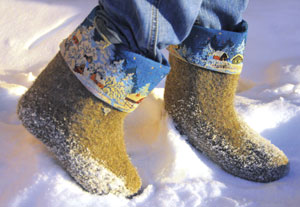 This is when the clothes that make Muscovites or the inhabitants of St. Petersburg laugh come in handy: ushanka1, telogreika2 and vatniki3. However, one of these garments has managed to move from rustic wardrobe to fashionable accessory to be decorated, embroidered and covered with rhinestones or even jewellery. The garment in question is a pair of valenki: felt high boots made from fulled sheep's wool. They are traditional Russian footwear and the best solution in the world to keep feet warm.
This fashion is not modern, though. For the last 100 years, this piece of clothing has been a regular guest at Soviet and international fashion shows. Valenki were previously used as a means to surprise the public and get wider press coverage. They were especially popular in Europe where Communism was feared, but the Soviet Union attracted interest. 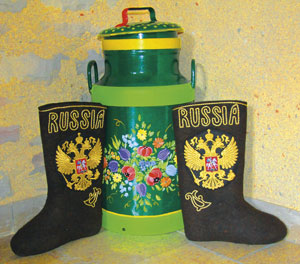 The history of valenki is quite simple. Sheep's wool was used as trusty protection against the cold as early as the 4th century B.C. At the time, it was mostly used to fortify dwellings: car- pets and rags were made of it, walls were padded with wool felt to catch hostile arrows and felt was used to make blankets and pillows. Then this material got "closer to body", as wool was used as padding for chain armour and helmets, and as part of the insoles. Felt boots appeared later and looked different from modern-day valenki: due to the lack of technology, felt boots were sewn from different parts and couldn't guarantee 100 per cent protection from the cold, as seams could distend or even come apart at any moment.
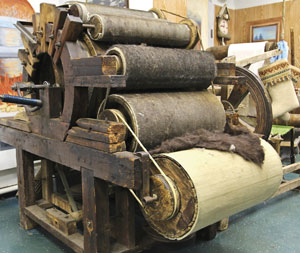 Only in the early 18th century did valenki acquire their now usual shape, when they started to be felted as a whole, including the bootleg. However, they still had a significant defect: perfectly protecting feet from the cold, boots quickly got wet from slush and wet snow. The problem was solved with the help of galoshes. Later, the makers used leather then rubber soles.
By the way, here are some facts from the official history of valenki. There is some evidence that both Peter the Great and Russian Empress Anna Ioanovna wore this foot- wear on casual occasions. It is worth mentioning that at the time valenki were not cheap as there was no mass production and each pair was felted by hand, which required physical strength and a lot of patience. Valenki were an expensive gift and were passed down from generation to generation, as well as the felting technology itself. Eventually, this knowledge spread throughout the villages. With that said, as is usual with craftsmen, each of them had their own manufacturing secrets, making the valenki produced in different places very distinct from each other.
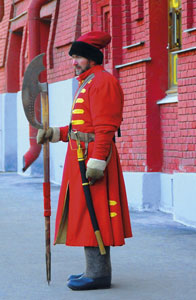
Making valenki from felt was easy: wool clip was washed and combed then put through a special woolarding machine, which rolled the layers together. This resulted in a soft fabric, which was then painstakingly smoothened with fingers to put the wool together and shape a boot. Thereafter, a raw piece was put into boiling water before being stretched on a last to get the final look.
Valenki became widespread only in the first half of the 18th century when they started to be manufactured by industrial methods.
But the industrialisation of the 20th century affected interest in valenki as well. Cities in which winters were not so severe switched to mass producing and selling more practical footwear made of rubber, textile or leather. Animal fur was used more often, too. Winter slush and temperature changes made boots entirely made of sheep's wool less relevant. Nonetheless, this didn't bring down demand for valenki in Siberia or regions above the Arctic Circle.
Nowadays, valenki serve primarily as part of the winter uniforms of Russian military, police and services working under extreme conditions. They have been and still are the most reliable footwear to keep feet warm. 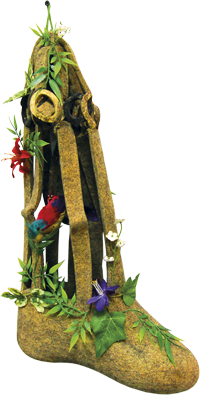
Modern fashion imposes new tendencies. Searching for national identity, Russian designers don't just include valenki in their shows as their colleagues used to, but transform them by adding quirky elements to the grey surface, dyeing the texture and applying textile ornaments. Contemporary valenki are a real display of creative imagination. They target people who want to stand out from the crowd and show their ethnic roots as well. On the other hand, a traditional Russian craft has now become an excellent souvenir and gift for foreign friends and colleagues.
At the end of the day, despite the abundance of choice in shoe shops, valenki haven't lost their relevance and are no- where close to becoming just a part of someone's memories. Simple statistics show that eight Russian factories manufacture more than two million pairs of valenki per year! This production is in response to demand for the same footwear that saved and warmed people for centuries, which is now aesthetically pleasing to them as well.
1 A fur hat with earflaps that may be tied below the chin to protect the ears, face and neck from the cold – Here and after comments by the editor
2 A cotton wool-padded jacket
3 Cotton wool-padded pants
Текст Михаил Танцура
Фото Наталья Макарова, Михаил Танцура
|
 +65 6696 7068
+65 6696 7068
 info@meridian103.com
info@meridian103.com
 PDA
PDA
 +65 6696 7068
+65 6696 7068
 info@meridian103.com
info@meridian103.com
 PDA
PDA
